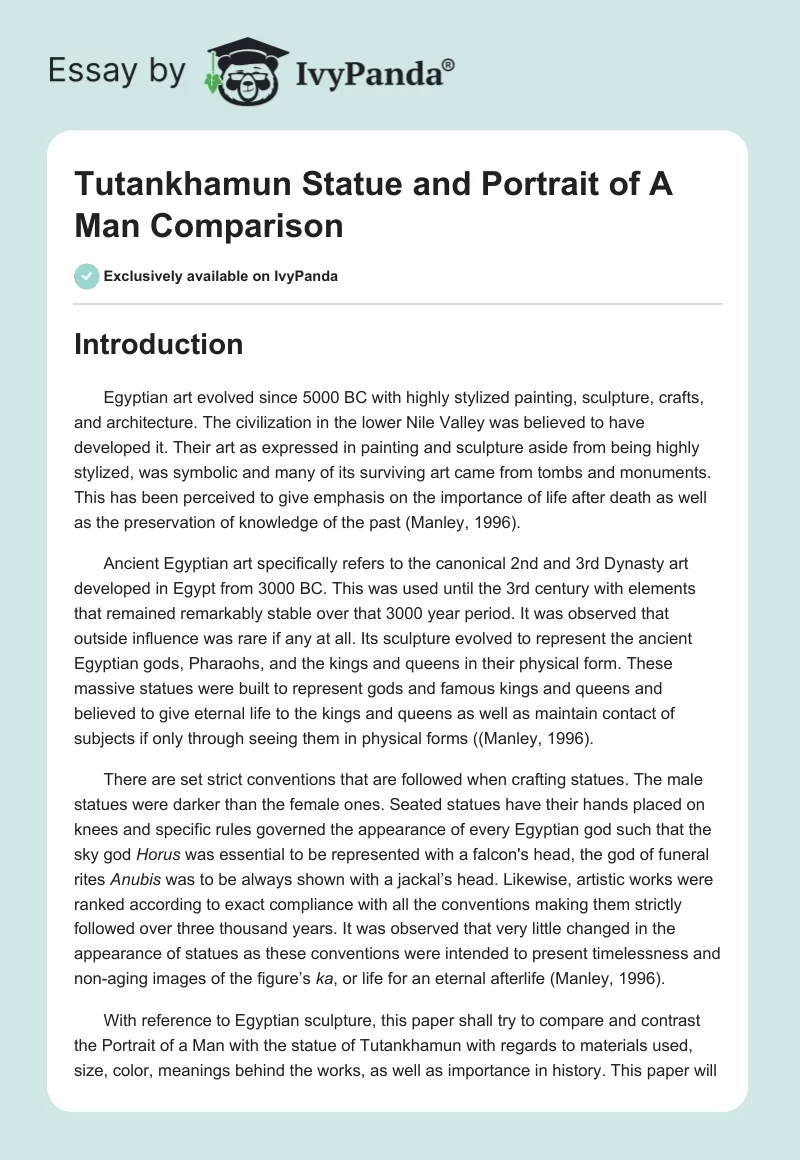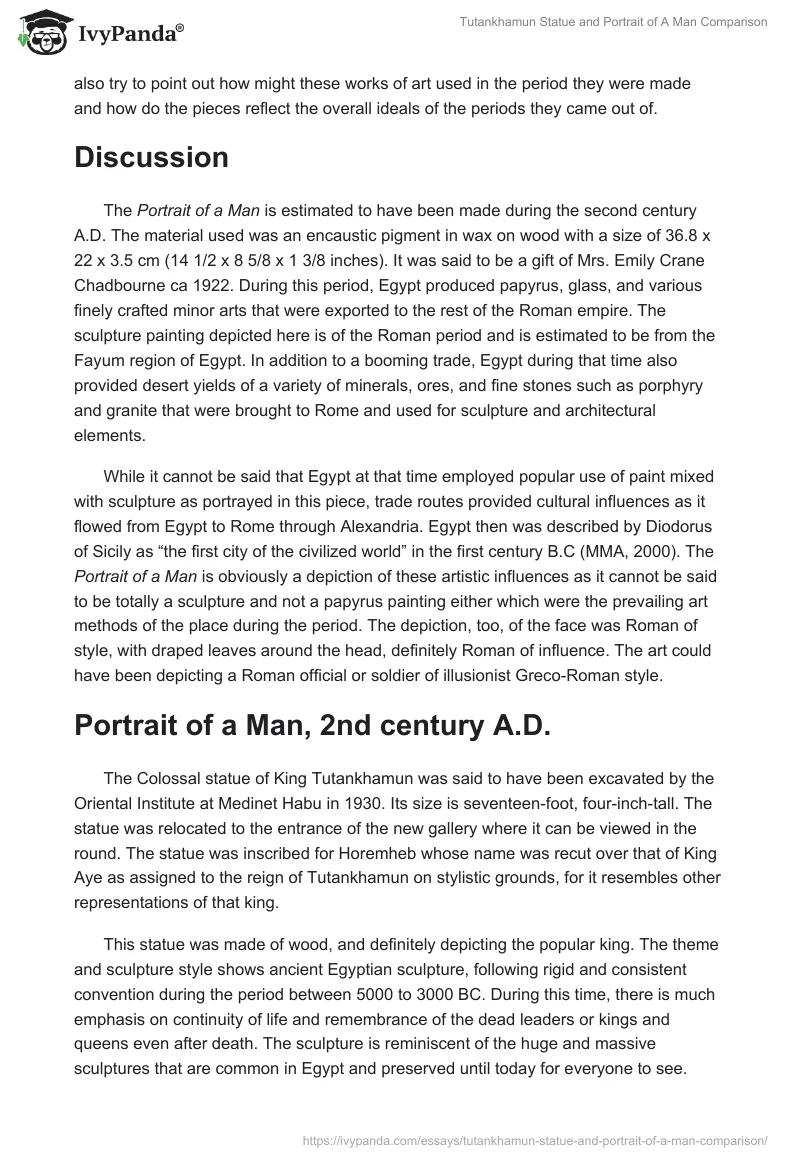Introduction
Egyptian art evolved since 5000 BC with highly stylized painting, sculpture, crafts, and architecture. The civilization in the lower Nile Valley was believed to have developed it. Their art as expressed in painting and sculpture aside from being highly stylized, was symbolic and many of its surviving art came from tombs and monuments. This has been perceived to give emphasis on the importance of life after death as well as the preservation of knowledge of the past (Manley, 1996).
Ancient Egyptian art specifically refers to the canonical 2nd and 3rd Dynasty art developed in Egypt from 3000 BC. This was used until the 3rd century with elements that remained remarkably stable over that 3000 year period. It was observed that outside influence was rare if any at all. Its sculpture evolved to represent the ancient Egyptian gods, Pharaohs, and the kings and queens in their physical form. These massive statues were built to represent gods and famous kings and queens and believed to give eternal life to the kings and queens as well as maintain contact of subjects if only through seeing them in physical forms ((Manley, 1996).
There are set strict conventions that are followed when crafting statues. The male statues were darker than the female ones. Seated statues have their hands placed on knees and specific rules governed the appearance of every Egyptian god such that the sky god Horus was essential to be represented with a falcon’s head, the god of funeral rites Anubis was to be always shown with a jackal’s head. Likewise, artistic works were ranked according to exact compliance with all the conventions making them strictly followed over three thousand years. It was observed that very little changed in the appearance of statues as these conventions were intended to present timelessness and non-aging images of the figure’s ka, or life for an eternal afterlife (Manley, 1996).
With reference to Egyptian sculpture, this paper shall try to compare and contrast the Portrait of a Man with the statue of Tutankhamun with regards to materials used, size, color, meanings behind the works, as well as importance in history. This paper will also try to point out how might these works of art used in the period they were made and how do the pieces reflect the overall ideals of the periods they came out of.
Discussion
The Portrait of a Man is estimated to have been made during the second century A.D. The material used was an encaustic pigment in wax on wood with a size of 36.8 x 22 x 3.5 cm (14 1/2 x 8 5/8 x 1 3/8 inches). It was said to be a gift of Mrs. Emily Crane Chadbourne ca 1922. During this period, Egypt produced papyrus, glass, and various finely crafted minor arts that were exported to the rest of the Roman empire. The sculpture painting depicted here is of the Roman period and is estimated to be from the Fayum region of Egypt. In addition to a booming trade, Egypt during that time also provided desert yields of a variety of minerals, ores, and fine stones such as porphyry and granite that were brought to Rome and used for sculpture and architectural elements.
While it cannot be said that Egypt at that time employed popular use of paint mixed with sculpture as portrayed in this piece, trade routes provided cultural influences as it flowed from Egypt to Rome through Alexandria. Egypt then was described by Diodorus of Sicily as “the first city of the civilized world” in the first century B.C (MMA, 2000). The Portrait of a Man is obviously a depiction of these artistic influences as it cannot be said to be totally a sculpture and not a papyrus painting either which were the prevailing art methods of the place during the period. The depiction, too, of the face was Roman of style, with draped leaves around the head, definitely Roman of influence. The art could have been depicting a Roman official or soldier of illusionist Greco-Roman style.
Portrait of a Man, 2nd century A.D.
The Colossal statue of King Tutankhamun was said to have been excavated by the Oriental Institute at Medinet Habu in 1930. Its size is seventeen-foot, four-inch-tall. The statue was relocated to the entrance of the new gallery where it can be viewed in the round. The statue was inscribed for Horemheb whose name was recut over that of King Aye as assigned to the reign of Tutankhamun on stylistic grounds, for it resembles other representations of that king.
This statue was made of wood, and definitely depicting the popular king. The theme and sculpture style shows ancient Egyptian sculpture, following rigid and consistent convention during the period between 5000 to 3000 BC. During this time, there is much emphasis on continuity of life and remembrance of the dead leaders or kings and queens even after death. The sculpture is reminiscent of the huge and massive sculptures that are common in Egypt and preserved until today for everyone to see.
Tutankhamun is an Egyptian Pharaoh during the eighteenth dynasty or the period 1333 BC – 1324 BC in the conventional chronology. He reigned during the period of Egyptian history known as the New Kingdom. It was said that his original name Tutankhaten means the “Living Image of Aten”, while Tutankhamun means the “Living Image of Amun”. It was believed that he could also be the Nibhurrereya of the Amarna letters. In addition, he was likely the eighteenth dynasty king “Rathotis”, who according to ancient historian Manetho, reigned for nine years (Carter, 1997).
Tutankhamun was not considered a notable pharaoh in ancient times. In fact, the size of his relatively small and forgettable tomb was said to be the reason the tomb was not discovered or opened until modern times. However, the 1922 discovery by Howard Carter of Tutankhamun’s intact tomb called KV62 had received much worldwide press coverage as well sparked a renewed public interest in ancient Egypt. This has made Tutankhamun’s burial mask a very popular face. Tutankhamun today is one of the most famous of the pharaohs with the only one to have the nickname King Tut in popular culture (Carter, 1997).
It was believed that Tutankhamun was only eight or nine years old when he became pharaoh. He reigned for an estimated ten years so that he could only be eighteen or nineteen years old at his time of death. Historically, Tutankhamun’s importance was his rejection of the radical religious innovations introduced by his predecessor Akenhaten (Hoving, 1978). In addition, his tomb considered to be unique in the Valley of the Kings was discovered almost completely intact and the most complete ancient Egyptian tomb found in history. Nevertheless, it was presumed that as Tutankhamun was a very young pharaoh, his vizier and eventual successor Ay made many of the important political decisions during his time.
Comparison and contrast
The Portrait of Man and the statue of Tutankhamun came from two distinct periods of Egyptian history. While the latter is of ancient origin, pure and following traditional if not strict Egyptian sculpture convention, the former is of mixed influence showing Greco-Roman influences. The statue is a sculpture while the Portrait of A Man is a part-painting and part sculpture as it was rendered on wood. Likewise, while the Tutankhamun statue represents the religious significance of after-life, the portrait seems to depict a Roman official neither deifying nor religiously symbolical. The materials used were of wood, but the statue was sculpted while the portrait was painted using encaustic pigment.
In each of their periods, the statue of Tutankhamun was of political as well as the religious significance that could have been quite experimental as was decided upon his vizier and successor, while that of the portrait could be perceived as purely political.
Conclusion
The Portrait of a Man is almost ordinary had it been done more recently as it depicted a non-identified man. Its style however showed the cross-cultural influences during its time as Egypt was annexed as a territory of Rome. The trade between the ancient cities that include Alexandria, Rome, and Egypt could have inspired a mix of the prevailing art styles during the era, successfully replicated in the portrait.
On the other hand, the statue of Tutankhamun confirms the tradition during the ancient period of Egypt, how the sculpture was an almost perfected art form depicting and deifying their pharaohs and queens, in massive stone or wood structures that would stand the test of time. Although the former used more materials of wood and encapsulated pigment, and the statue of wood, their importance and significance were not proportionate, the statue is of an older, therefore earlier and of antiquity, and the portrait representing a period of Roman Egypt.
While the older sculpture was used as a political and religious symbol depicting the rigid discipline of sculptors during that time, the portrait also successfully depicted an early colonial as well as the inter-cultural era in Egypt with a centuries-old tradition of art methods and styles.
Reference
Carter, Howard and Arthur C. Mace (1997). The Discovery of the Tomb of Tutankhamun. Courier Dover Publications.
Hoving, Thomas (1978). The search for Tutankhamun: The untold story of adventure and intrigue surrounding the greatest modern archeological find. New York: Simon & Schuster.
Manley, Bill (1996). Historical Atlas of Ancient Egypt.
Metropolitan Museum of Art, The (2000). “Roman Egypt.” Web.


